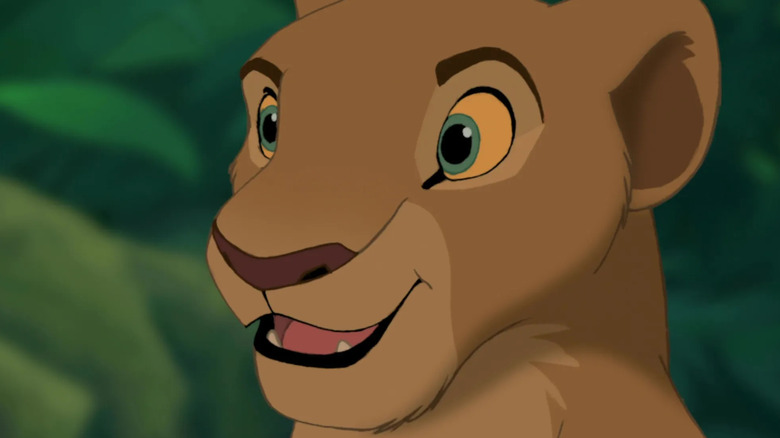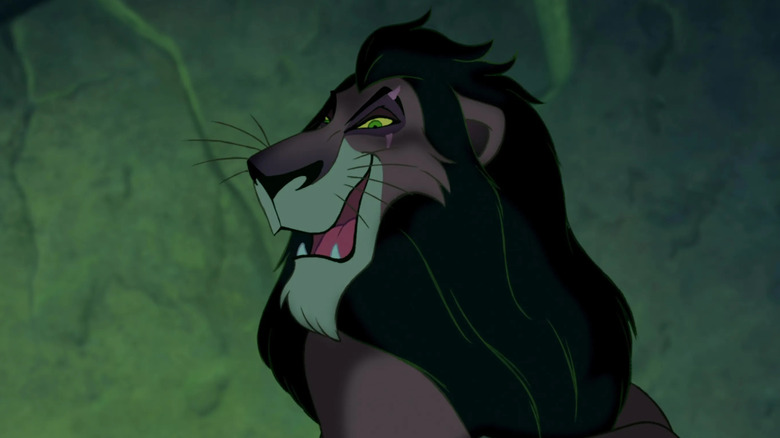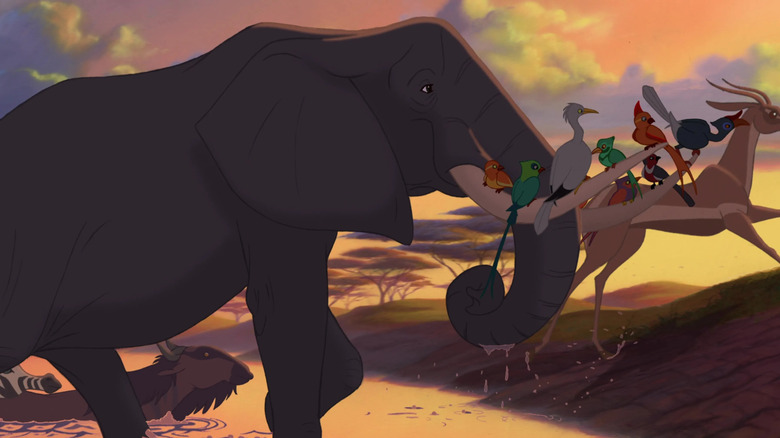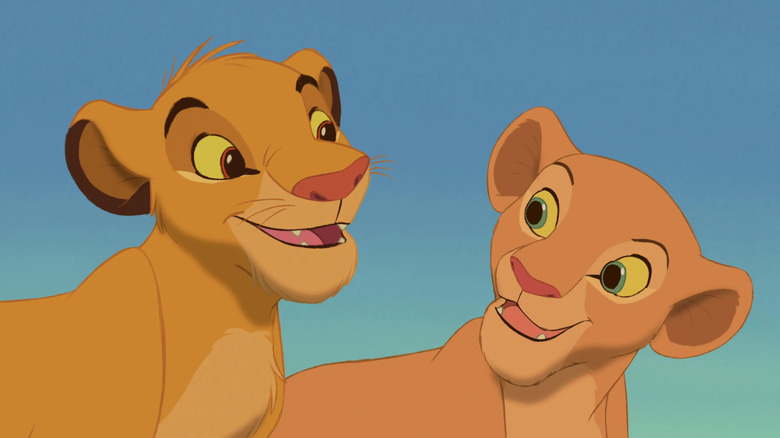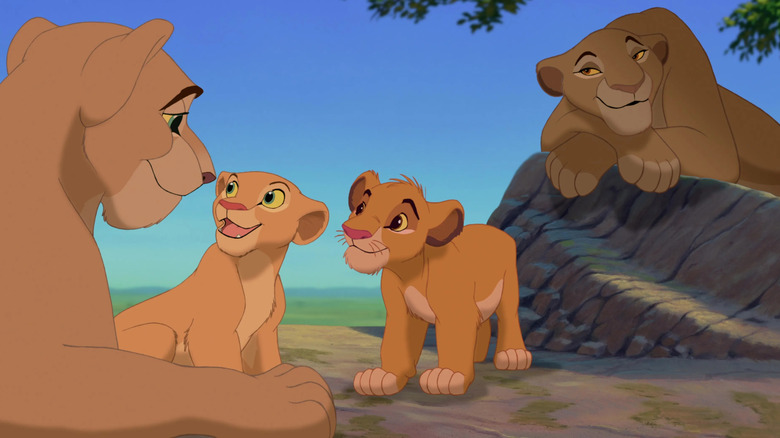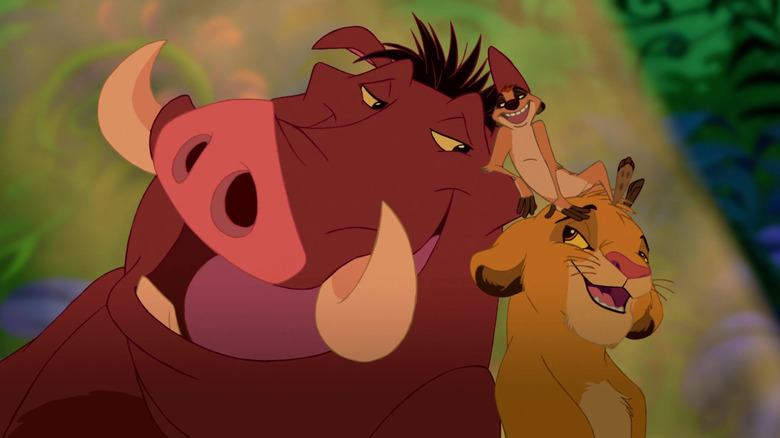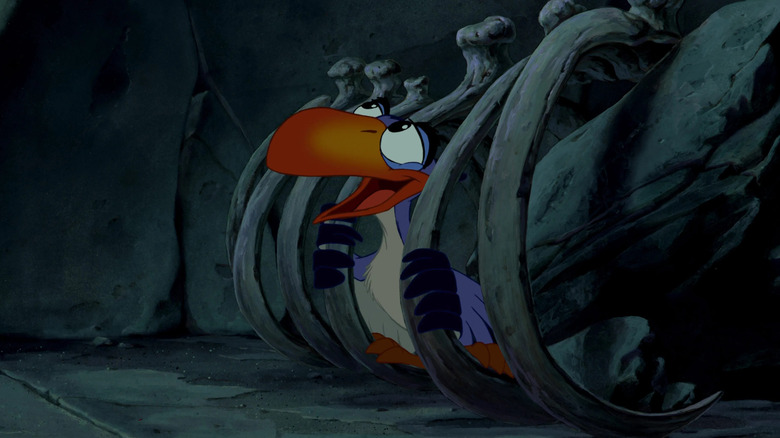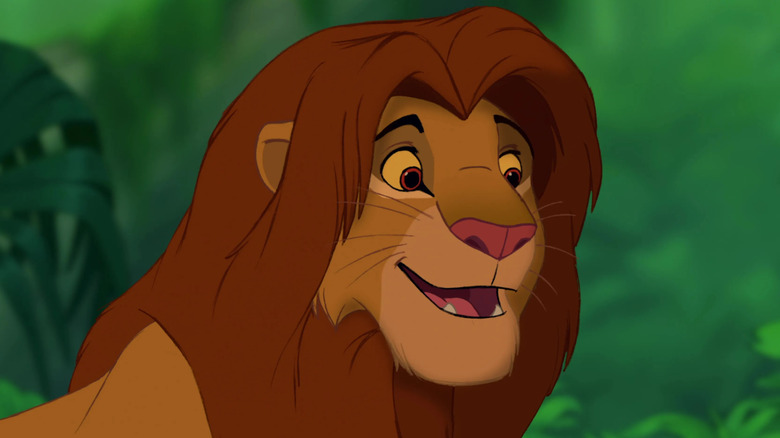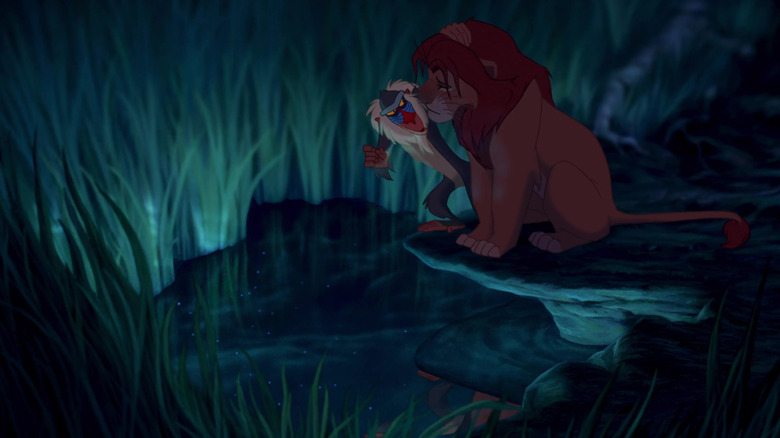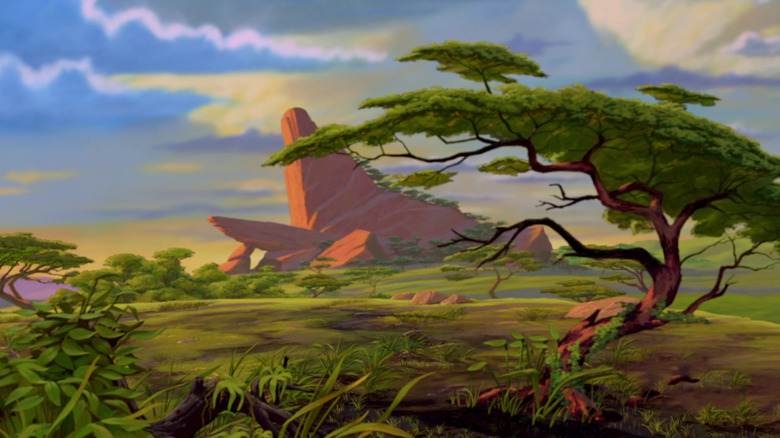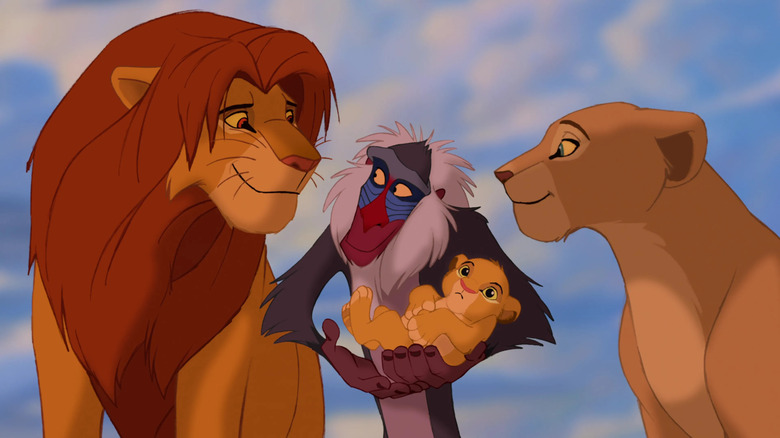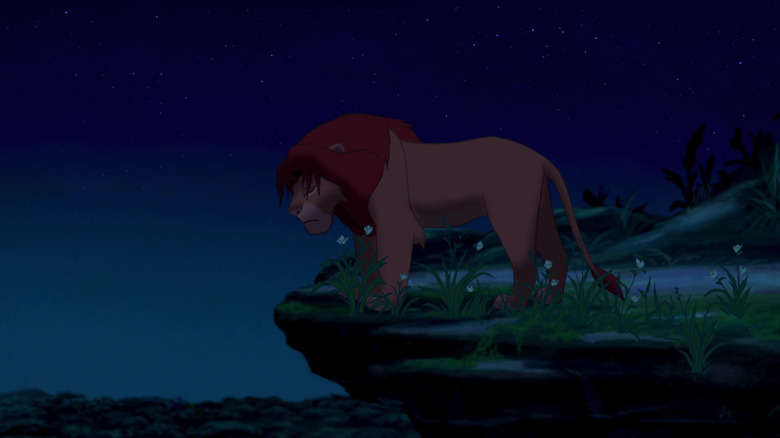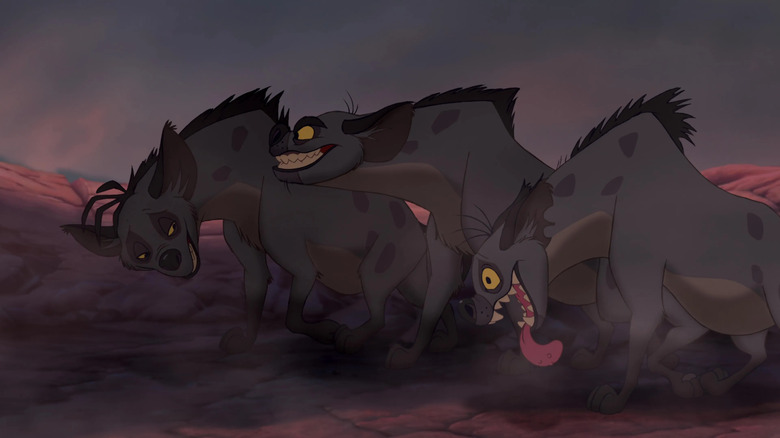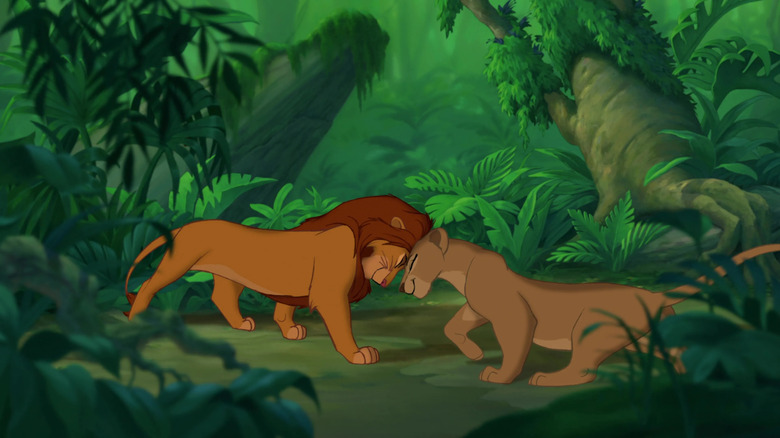Biggest Unanswered Questions In The Lion King
Disney's 1994 animated classic "The Lion King" has endured for nearly three decades, as an anchor for Disney in its animation, storytelling and ancillary efforts. Within its narrative, the film pauses to reflect on questions of its own world-building and answer them from its own characters' perspectives. For example, what are those sparkling dots above us at nighttime, you may wonder? Depending on who you ask, they're either "fireflies that got stuck in that big, bluish, black thing," "the great kings of the past looking down on us," or "balls of gas burning billions of miles away."
As well as "The Lion King" holds up today, continuing to stand the test of time, there are still a few gray areas in the movie's story and characters that aren't fully explained. Here are the biggest unanswered questions in the Roger Allers/Rob Minkoff-directed '90s animation classic "The Lion King."
Has Scar's name always been Scar?
Mufasa's brother and Simba's uncle does indeed have a scar on his face, across his left eye. But, why would anyone name a baby Scar?
It's possible that Scar's scar is a birthmark, something he was born with; if that's true, wow, his parents were mean. When your brother's name is "Mufasa" and your name is "Scar," that's going to set up some tension — no wonder the guy is such a jerk.
If "Scar" is a nickname, which feels far more likely, this also prompts follow-up questions. How did he get the scar? Was he involved in some sort of fall or accident, or was he struck across the face by another animal? If so, who was it and what happened to them? Did Scar start calling himself by that name, or did others place the name upon him derisively, and he finally just went with it?
No matter which scenario is true (if an official backstory exists among Disney animators, nobody has explained it), both are equally unfortunate for the film's villain and only seem to foreshadow his unpleasant path.
Are the animals really okay with the circle of life?
As Mufasa gives Simba a tour of the kingdom over which the young cub will one day reign, the king explains the "circle of life" to his son. Mufasa says, "Everything you see exists together in a delicate balance. As king, you need to understand that balance, and respect all the creatures, from the crawling ant to the leaping antelope." He continues, "When we die, our bodies become the grass and the antelope eat the grass. And so we are all connected in the great circle of life."
This logic is meant to explain how the Pride Lands work together in harmony, and how the region prospers when governed by this philosophy under Mufasa's rule. Although Mufasa seems tranquil as he explains this mindset to Simba, it's hard to not wonder if other animals who might be lions' prey think of the circle of life in the same way. After all, these lions are at the top of the food chain; they live a life that could be seen as, in modern vernacular, entitled.
Is there a similar respect among prey for the companions they lose? This perspective is never shown onscreen; there aren't any named characters who are part of this dynamic, making it easy to gloss over and not fully consider. Nonetheless, everyone is at the very least gung-ho at Simba's presentation ceremony, excited to welcome and bow to their future king.
Are there other cubs in the pride?
Zazu informs young Simba and Nala that they are "betrothed, intended, affianced," and otherwise selected by their parents to one day marry one another. When they grow old, they will rule the Pride Lands together as king and queen. While this ends up happening on its own accord, as Simba and Nala become romantically attracted to each other, the notion that Mufasa and Sarabi selected Nala as Simba's future queen implies that there were other female lion cubs to choose from. Despite this, the only young lions the audience ever sees are Simba and Nala.
Do other cubs exist? If so, where are they? Are they simply not present for the story the animators chose to tell? Or is there some sort of class system within the Pride Lands that separates other cubs from interacting with the young prince and his betrothed princess? If it's the latter, that means Nala is Simba's only friend his age by design of the patriarchy, which Simba likely doesn't even realize. These questions admittedly jump to assumptions made from very little evidence, but within the framework that the story provides, they nevertheless come to mind.
Also, it's easy to imagine Simba and Nala's parents probably weren't too happy when they found out the king's majordomo outed this crucial information to their cubs, which was apparently being kept a secret until they felt the kids were at an appropriate age to know. Not cool, Zazu.
Where is Nala's father?
While we briefly meet Nala's mother, Sarafina, we never see Nala's father. If the biology of lions tells us anything, there's quite a story to explore with his absence.
Mufasa and Scar are the only adult male lions present onscreen. Meanwhile, roughly a dozen female lions are visibly present throughout the film, all belonging to Mufasa/Scar's pride. According to National Geographic, "at around two to three years old, young males leave the pride and attempt to take over another male's pride." Britannica explains that among lions, "sexual maturity is reached at three or four years of age." This means it's theoretically possible for a male lion to become a father before he leaves his original pride to dominate another pride.
So, within the bizarre, hypothetical conversation of overthinking "The Lion King," let's play this out. It's possible that Nala's dad conceived Nala with Sarafina and then left Pride Rock to do his loner thing. Could it also be possible, though, that Mufasa is Nala's dad? "Both sexes [of lions] are polygamous," Britannica writes, meaning Sarabi might not be Mufasa's only mate despite being his queen. Mufasa could have mated with Sarafina, making Nala his daughter. This would then mean Simba and Nala are siblings who later mate with each other, which Only Zoology says does happen in the wild.
How far away is Simba from the Pride Lands when he runs away?
Following Mufasa's death, Simba runs away from his home, led to believe it's his fault his father is dead. He runs until he passes out of exhaustion in a dry plain, where Timon and Pumbaa find him. They bring Simba to the luscious, tropical jungle where they reside, and Simba stays there until adulthood. While it's unclear how far Simba travels before Timon and Pumbaa discover him, nor is it mentioned how long it took him to get there, the voyage seems like it could be anywhere from a few hours to several days
The reverse pilgrimage is likewise unclear. Eventually Simba returns to Pride Rock, and is shown sprinting through a desert in slow-motion. Timon, Pumbaa, and Nala follow him separately on his voyage, but again the distance and travel time is never addressed. No matter the physical measurements, mentally Simba couldn't have been further removed from his home. As Nala explains, everyone believes him to be dead, and he altogether doesn't consider himself king.
How does Zazu know the song It's A Small World?
After Mufasa's death, Zazu is locked up in Scar's throne room, made to entertain the evil ruler in a manner similar to a court jester. From a makeshift jail cell, Zazu becomes an endless jukebox of real songs from the real world, a seeming non-sequitur for the otherwise timeless film.
Zazu begins with "Nobody Knows the Trouble I've Seen," which was first recorded in 1917 but whose origins go back to 1867 as a song traditional of American slaves. When requested by Scar to instead sing "something with a little bounce in it," Zazu switches gears and sings the chorus of "It's A Small World," the anthem of the Disney theme park ride of the same name, written in 1964. Scar immediately pleads, "No, no! Anything but that" alluding, perhaps, to the song's reputation as an unrivaled earworm. Finally, the pair settles on "I've Got A Lovely Bunch of Coconuts," a song dating back to 1944.
Spanning decades and various music styles, one has to wonder how Zazu gained such a repertoire of musical history for being so removed from popular culture. Are these songs well-known by everyone, or just Zazu and Scar? In this universe, were these songs originally written by humans, or is there an animal version of Walt Disney somewhere and therefore a Disneyland in the timeline of "The Lion King"?
How much time passes between when Simba runs away from and returns to Pride Rock?
Simba runs away from the Pride Lands when he's still a cub, and doesn't return until he's well into adulthood. While nothing in the script indicates how long his time away from home may have been, you can look to lion biology for a hint at what this length might be. According to the Mara Predator Project, male lions can mature anywhere between three years old and eight years old. That's quite a range, but it can further be narrowed through pictures the site shares of lions' manes in varying stages of growth.
Using Mara's photos as a barometer, the length and thickness of the mane Simba appears to have after the movie's time jump places him at around seven years old. Since male lions can start growing manes as early as two years old, and the cub version of Simba shows no indication of any mane, this hypothetical timeline means Simba stays with Timon and Pumbaa in the jungle for at least five years, most of his life up to that point.
How does Rafiki have magic?
While never fully explained, Rafiki the mandrill is clearly some sort of shaman or spiritual figure to the animals of the Pride Lands. During baby Simba's presentation at the beginning of the film, Rafiki gently wipes sand and liquid from a coconut across Simba's forehead, performing what is likely a ritual of spiritual significance.
Later in the film, Rafiki uses his finger to actually change the reflection Simba sees inside a pond to be that of his father, Mufasa. This action takes Rafiki beyond simply being a wise sage perhaps representative of an unexplained religion, and instead posits him as possessing actual magic. The extent of Rafiki's mystic powers are never explained, nor is the origin of how he came to gain them or if there are others like him. As far as the audience knows, he is the only one of the cast's eclectic characters to possess such abilities, and the only animal to command the spiritual reverence commensurate with them.
How does Simba reverse Scar's terror?
Mufasa's policies as king regard the "circle of life" as a "delicate balance" between predator and prey. In contrast, Scar's betrayal of this balance later in the film demonstrates the turmoil that happens when predators take advantage of their position in the food chain and hunt more than they necessary. When Simba returns to the Pride Lands and challenges Scar to take his place as king, the home he finds is an abysmal wasteland, nothing like the prosperous ecosystem that existed under Mufasa.
In the film's epilogue, as Simba and Nala celebrate the birth of their child, the Pride Lands have once again been restored to their former glory, abundant in plant life and populous with healthy numbers of animals. Simba must be one heck of a leader to be able to pull off such a turn-around. What was his plan? What did he do? How did he build Pride Rock from the ground up, seeing as there were almost no living creatures left in the immediate vicinity? Whatever he did, it worked.
Which child is at the end of the movie: Kiara or Kion?
Prepare yourself for some brain-breaking semantics here. At the conclusion of "The Lion King," all the animals of the Pride Lands gather together once more as Rafiki presents Simba and Nala's new cub. The little tyke appears identical to the baby Simba from the beginning of the film, his fur golden yellow. At the beginning of 1998's "The Lion King 2: Simba's Pride," we are meant to believe the sequel's opening scene is the same moment as its predecessor's finale, with Rafiki holding up a baby cub. However, the child has been retconned to appear what the series' style guide would indicate as a female lion, more vanilla-colored than golden and clearly resembling the facial features of Kiara, Simba and Nala's daughter.
That's all there was to this story for almost two decades. However, in 2015, Disney Junior debuted a new television show, "The Lion Guard," which revealed that Kiara has a younger brother, Kion, who fans never previously knew about. Kion's fur is golden like Simba's. This begs the question: Whose birth are we celebrating at the end of "The Lion King"?
If going in sequence, it's Kiara's, and fans just have to accept the fact that she looks different in the sequel. If going strictly by appearance, the end of "The Lion King" apparently jumps forward in time to present the birth of Simba and Nala's second child, Kion.
How does Simba process the truth?
Distraught after Mufasa's death, young Simba is manipulated by Scar into believing it's his fault that his father died. Scar convinces him his only option is to run away, and Simba spends his entire youth and early adulthood thinking he is responsible for his father's death. That's a heavy burden, and Simba lives with guilt every day. As he looks to the sky in anguish, he cries out to Mufasa, "You said you'd always be there for me! But you're not. It's because of me. It's my fault. It's my fault."
When Nala convinces Simba to return to Pride Rock and take his rightful place as king, Simba is surprised to realize Mufasa's death wasn't his fault at all, but Scar's. He responds by overthrowing Scar and taking back the kingdom, but there's gotta be some trauma for poor Simba to unpack. He spent most of his life believing he did something terrible, only to learn he was innocent, meaning there was theoretically no reason to run away in the first place. Taking this thought to its natural next step, this means the ruination of the Pride Lands didn't have to happen at all.
Are the hyenas loyal to Simba now?
The hyenas view Scar as their leader, even before the evil lion actually becomes king. They're indispensable in the plot to kill Mufasa, and remain Scar's henchmen throughout his rule of the Pride Lands. Toward the end of the film, though, they finally see Scar's true colors. He hasn't really cared for the hyenas all this time, he's just taken advantage of their servitude. He's certainly quick to place the blame on them when confronted by Simba. It's the hyenas themselves who finally dispose of Scar, and the last time they're shown on screen is when they attack and seemingly eat him.
Now that Scar is gone, and the hyenas have been loyal to him for as long as we've known them, do they acknowledge and respect Simba as their rightful king now? We never really know for sure. There are no hyenas in "The Lion King 2: Simba's Pride," though the TV series "The Lion Guard" does seem to show both good and bad hyenas, so maybe the situation isn't as cut-and-dry as the original film made things seem.
What other rules do Simba and Nala abridge?
While Simba and Nala fall in love on their own, they ultimately still align with their parents' wishes since childhood for them to be coupled. In "The Lion King 2: Simba's Pride," their daughter, Kiara, falls in love with a lion named Kovu. While Simba initially dislikes Kovu, his reasons have nothing to do with any sort of betrothal rule and everything to do with a deep-rooted prejudice toward Kovu's pride. While that's troubling in itself, eventually Simba comes around and accepts Kovu. This, in effect, means that Simba and Nala have seemingly done away with the tradition of betrothed royals, established by the generations before them.
If Simba and Nala are willing to break tradition on this subject, it's interesting to imagine what other political changes of culture may have been instituted under their leadership. Were there other policies enacted by Mufasa and Sarabi that Simba and Nala similarly abridged?
